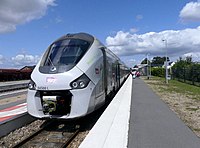
Photo from wikipedia
Today, vehicles especially diesel engines emitted a large amount of NOx in the urban areas. So, it is required to find ways such as SCR catalysts to reduce this hazard… Click to show full abstract
Today, vehicles especially diesel engines emitted a large amount of NOx in the urban areas. So, it is required to find ways such as SCR catalysts to reduce this hazard pollutant emission. In this work, a 3D model of cordierite/Pt SCR catalyst has been developed by using AVL FIRE software to analyze the NOx conversion efficiency. The simulation was performed based on experimental tests conducted on a single-cylinder engine. The exhaust gas from the engine that appears at the inlet of the catalyst was measured for E20B50D30 (20% ethanol, 50% biodiesel, 30% diesel) D100, E10D90, E20D80, B25D75 and B50D50 fuel blends at the engine speeds of 1800, 2150 and 2500 rpm under full load. The results showed that an increase in the engine’s rotational speed resulted in a reduction of NOx conversion, and the conversion rate reaches its minimum value at speed of 2500 RPM for all fuel mixtures. Moreover, increasing the ammonia mass flow rate resulted in higher NOx conversion for all fuel mixtures. However, the effect of increasing ammonia flow rate from 0.2 to 0.3 kg/h on the NOx conversion is lower than that when the ammonia mass flow changes from 0.1 to 0.2 kg/h. The maximum NOx conversion rate was observed for the mixture containing 20% ethanol and 80% diesel at the rotational speed of 1800 RPM while the lowest conversion rate is observed for pure diesel fuel. According to the results, it was seen that the SCR catalytic process for fuel blends contained ethanol have a better performance to reduce the NOx pollutant compared to the mixtures containing biodiesel at lower engine speeds; but at higher rotational speeds ethanol and biodiesel has not a positive effect on the NOx conversion. Graphic Abstract
Journal Title: Catalysis Letters
Year Published: 2020
Link to full text (if available)
Share on Social Media: Sign Up to like & get
recommendations!